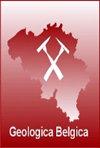On the use of CPTs in stratigraphy: recent observations and some illustrative cases
IF 0.7
4区 地球科学
Q2 GEOLOGY
引用次数: 6
Abstract
1. Introduction During 2008 and 2010 the National Institute for Radioactive Waste and Enriched Fissile Materials (ONDRAF/NIRAS) organized two comprehensive field test campaigns (Wouters & Schiltz, 2013) situated in the NE of Flanders. The subject of these field campaigns was a hydrogeological safety study for a disposal facility for low radioactive waste storage. This investigation area is situated in the NE of the Flanders region in Belgium, at the Dessel nuclear site and a surrounding safety area on the territory of the Dessel–Geel–Kasterlee communities (Fig. 1). This field test campaign consisted in seven cored and logged boreholes and of about 200 CPTs (depth up to 35 m) in a regular grid of ~1 km² over an area of ~60 km² in the Dessel–Geel–Kasterlee area. This area is situated in a geological setting where, under a thin (1–4 m) cover of Quaternary sediments, Miocene sandy sediments outcrop (Fig. 1). In some preliminary minor field campaigns one of the cored boreholes revealed the presence of a ~10 m thick clayey layer on a stratigraphic level that was supposed to be sandy. Obviously the primary objective of the large number of CPTs was determining the presence and extension of this aquitard. It turned out that these data were also valuable in the discussion of the complex detail stratigraphy of the area. Therefore CPT data have been integrated in the unravelling of the local stratigraphy as presented in Vandenberghe et al. (2020, this volume). More information on the CP关于在地层学中使用CPTs:最近的观察和一些说明性案例
1. 在2008年和2010年期间,国家放射性废物和浓缩裂变材料研究所(ondraft /NIRAS)在佛兰德斯东北部组织了两次全面的现场测试活动(Wouters & Schiltz, 2013)。这些实地活动的主题是关于低放射性废物储存处置设施的水文地质安全研究。该调查区域位于比利时Flanders地区的东北部,位于Dessel - geel - kasterlee社区的Dessel - geel - kasterlee区域内的Dessel - geel - kasterlee区域内的Dessel - geel - kasterlee区域内的Dessel - geel - kasterlee区域内的Dessel - geel - kasterlee区域内的Dessel - geel - kasterlee区域内的Dessel - geel - kasterlee区域内的Dessel - geel - kasterlee区域内的Dessel - geel - kasterlee区域内的Dessel - geel - kasterlee区域内的Dessel - geel - kasterlee区域内的Dessel - geel - kasterlee区域内的Dessel - geel - kasterlee区域内的7个取心钻孔和测井钻孔以及约200个cpt(深度达35米)。该地区位于一个地质环境中,在薄(1 - 4米)的第四纪沉积物覆盖下,中新世砂质沉积物露头(图1)。在一些初步的小型野外活动中,其中一个取心钻孔显示在地层水平上存在约10米厚的粘土层,该层应该是砂质的。显然,大量cpt的主要目标是确定这一标准的存在和延长。事实证明,这些数据在讨论该地区复杂的详细地层时也很有价值。因此,CPT数据已被整合到Vandenberghe等人(2020年,本卷)中对当地地层学的揭示中。更多关于CP的信息
本文章由计算机程序翻译,如有差异,请以英文原文为准。
求助全文
约1分钟内获得全文
求助全文
来源期刊

Geologica Belgica
地学-地质学
CiteScore
4.70
自引率
27.80%
发文量
8
审稿时长
>12 weeks
期刊介绍:
Geologica Belgica is a Belgian journal that welcomes papers concerning all aspects of the earth sciences, with a particular emphasis on the regional geology of Belgium, North West Europe and central Africa. Papers not dedicated to the geology of Belgium, North West Europe and central Africa are only accepted when one of the authors is linked to a Belgian University or Institution. Thematic issues are highly appreciated. In this case, guest editors take in charge the selection of the manuscripts and the subject of the papers can be enlarged. The journal is in open access.
Submitted manuscripts should be concise, presenting material not previously published. The journal also encourages the publication of papers from Belgian junior authors. Short letters are accepted. Papers written in English are preferred. Each mansucript will be reviewed by at least two reviewers.
 求助内容:
求助内容: 应助结果提醒方式:
应助结果提醒方式:


